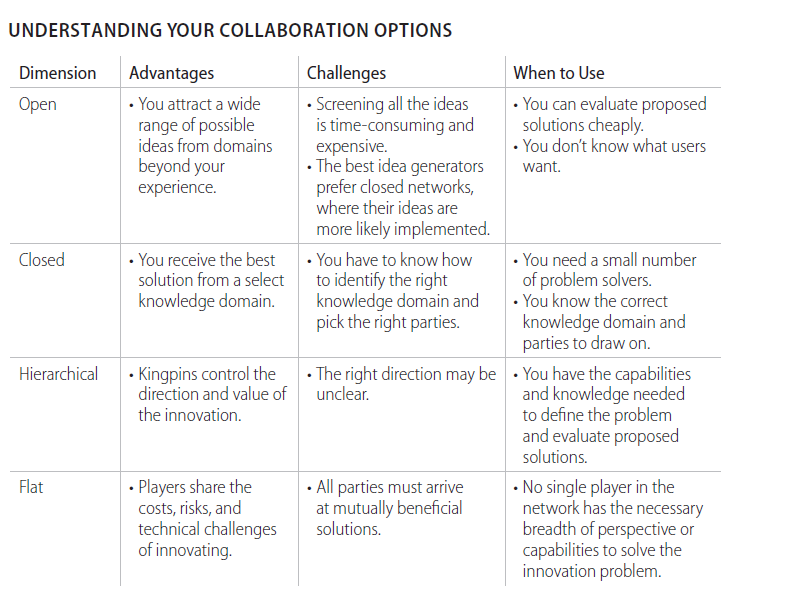Yesterday, I touched on the question regarding which is better for fostering innovation and creativity: collaboration or solitude. In that post, I came to the conclusion that the question is not this all-or-nothing debate. Rather it should be a question of which method of collaboration will bring us the results we want.
I’d like to tackle this question of finding the collaboration style that works best for your situation and aid you in your future collaborative efforts. As previously mentioned in my post, after twenty years of research Gary Pisano and Roberto Verganti have identified four main types of collaboration: Open, Closed, Hierarchical and Flat. In their Harvard Business Review article, Which Kind of Collaboration is Right for You?, The two explain the strengths and weaknesses associated with each method and offer up some ideas as to how best select the type that will work for your certain situation. So, given your strategy how open or closed, flat or hierarchical should your firm’s network of collaborators be?

Open – In totally open collaboration everyone is encouraged to participate (suppliers, customers, designers, research, institutions, students, hobbyists, possibly even competitors). A sponsor makes a problem public and then seeks support from a potentially unlimited number of sources. “The big advantage of an open network is its potential to attract an extremely large number of problem solvers and, consequently, a vast number of ideas.” (Pisano and Verganti)
However, the great thing about open collaboration networks is also one of its largest drawbacks – you do not know or are able to identify the best knowledge centers. “It’s like throwing an open house party: You just make it known you are having a party and provide the right inducements, and (you hope) the right people will show up.” (Pisano and Verganti) Because open networks are so unconstrained, you do run the risk of having them be not as effective as other approaches in identifying and attracting the best players, namely because as the number of participants increases the likelihood that a participant’s solution will be selected will decrease.
Open collaboration is only effective under certain conditions. For example, you must be able to evaluate the proposed solutions easily and inexpensively. Because of the volume of responses inherent in posing a question to the public, you run the risk of having an expensive and time consuming evaluation period. If you are unable to test proposed solutions quickly and cheaply then this isn’t the collaboration style for you. Also, “participation in them must be easy. That is possible when a problem can be partitioned into small, well-defined chunks that players can work on autonomously at a fairly low cost.”
Closed – Closed collaboration networks are like private clubs. “Here, you tackle the problem with one or more parties that you select because you deem them to have capabilities and assets crucial to the sought-after innovation.” As a result, closed networks are much smaller than open collaboration networks. When you select closed collaboration “you are marking two implicit bets: that you have identified the knowledge domain from which the best solution to your problem will come, and that you can pick the right collaborations in that field.” In contrast to open collaboration networks, closed ones are best suited for situations where you cannot partition the problem into smaller, autonomous pieces. In these situations, closed networks “provide an environment where collaborators can closely interact must be employed.”
Flat – In flat collaboration, the decisions are usually decentralized or made jointly by some or all collaborators. The advantage of flat collaboration networks is “the ability to share with others the costs, risks, and technical challenges of innovating.” Flat modes work best when no single organization has the necessary breadth or capabilities to respond to the problem at hand. Flat modes are also appropriate when collaborators all have a vested interest in how a particular issue is resolved and will participate only if they get some say in the decisions.
Hierarchical – In Hierarchical collaboration, a specific group or organization has the ultimate authority. This provides the advantage of controlling the decision and the direction of the innovation efforts. It’s important to note that hierarchical networks are desirable when the organization has the capabilities and knowledge needed to accurately define the problem and evaluate the purposed solutions.
Selecting the Right Type

How do we take advantage of our collaboration? How do we make sure we choose the right type? Really it all comes down to strategy. While figuring out the type of collaboration makes sense, it’s more than just understanding the various trade-offs. Selecting a collaboration method must also reflect the firm’s strategy and just like strategy it’s important to remember that as strategy and goals shift, so should your collaboration style.

